 |
Castillo de la Real Fuerza
Havana, Cuba
|
|
 |
Constructed: 1558-1577
Used by: Spain, Cuba
Conflicts in which it participated: None
|
The Castle of the Royal Force considers itself to be the oldest standing stone fort in the Western Hemisphere! Could this be true?! Sure, why not?We at Starforts.com do our best not to make definitive statements regarding the oldest, the biggest (unless we're talking about Fort Monroe of course), the prettiest, etc. when we're talking starforts, but this castillo may well be the oldest extant starfort in the New World. |
 |
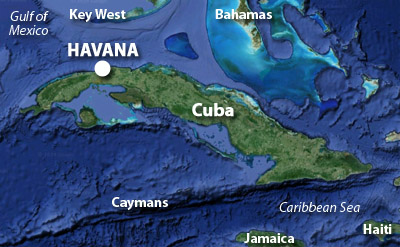 |
|
Havana was of great value to Spain. Much of the treasure that flowed into Spain's royal coffers came from their colonies in Central- and South America, and a good proportion of it filtered through Havana's lovely natural harbor, where the ill-gotten goods were loaded onto the famed galleons for their trip back to the motherland. The Caribbean was a haven for pirates, corsairs, freebooters, raiders, marauders...and French & English sailors, who were all of those things. Every one of these seaborne greedy persons knew what the Spanish were doing and where they were doing it, and attempts to intercept and purloin this boundless booty were constant.
Havana was founded in 1514, and soon had some semblance of a fort guarding it, which by the mid-16th century was known as the Fuerza Vieja (Old Fort). It couldn't have been all that old when French privateer Jacques de Sores and his merry band of royally-sanctioned pirates attacked Havana in 1555, expecting to find vast piles of gold lying all over the place. Sores and his pals were dismayed to find the opposite of lots of gold, which was no gold, and took their frustrations out on the city (which they burned), the Fuerze Vieja (which they damaged most severely) and the surrounding countryside (to which they laid waste).
You'd think all of that would have been enough to satistfy everyone, but before leaving Havana the pirates somehow also found the time to put on a play, making fun of the Pope...which in 1555 could have been either Julius III (1487-1555), Marcellus II (1501-1555) or Paul IV (1476-1559), all of whom served as Pope in 1555, and none of whom would have been pleased to learn that a bunch of French pirates were making fun of them 5400 miles to their west.
|
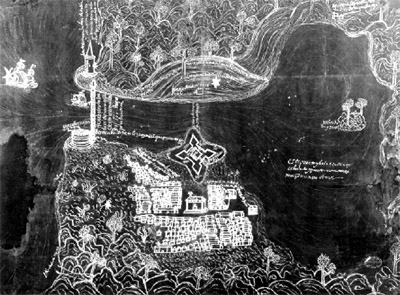 Plan of Havana In Perspective Showing the Castillo del la Real Fuerza by Francisco Calvillo, circa 1576...on a chalkboard?! The trace of the Castillo is certainly accurate, but the scale might be just a smidge off. |
 |
The relative ease with which Sores & co. captured and destroyed the city laid bare the need for proper fortification, lest the Pope be made fun of in a deliberate and organized manner on a regular basis in Havana. Spain's King Philip II (1527-1598) dispatched engineer Bartolomé Sánchez to Havana in 1558 for the express purpose of starfortification.
The new fort was initially and creatively called the Fuerza Nueva, the New Fort. No moss gathered on Sánchez, who got to work the instant his feet hit Cuban ground, but the Old Fort that the New Fort was replacing had been set back from the harbor, and the New Fort would be built on the harbor so as to better protect it, and the folks who had to relocate from their homes to make way for the New Fort complained, which for some reason slowed things down. |
|
|
I mean...You're the Spanish Empire, and you need to protect one of your most vital ports from guys who want to steal all of your already-stolen gold. Why would some townsfolk in Havana be permitted to get in the way of your sacred mission?! Sánchez was also delayed by an inability to get along with Havana's Governor, Francisco Carreño, but the first stones for the starfort of our current interest were finally laid in 1562. With the no doubt enthusiastic labor of slaves and French prisoners, who made up most of the workforce, our lovely starfort was completed in 1577.
One of the reasons the Old Fort had been unsuccessful in its intended role of defending Havana was that it was too far from the mouth of the harbor to prevent nautical Frenchmen from making it into the harbor. While the New Fort (which may or may not by this point have been called the Castillo de la Real Fuerza, but that's what we'll be calling it going forward) was purposefully built on the harbor, it was still at a great remove from the mouth of the harbor, which ultimately made it not that much more effective than the Old Fort had been.
|
But build a cool and secure structure, and a Governor will want to claim it as his own! Juan de Tejeda, who was Governor and Captain General of Cuba from 1580 to 1594, announced that henceforth the Castillo de la Real Fuerza would serve as the Governor's mansion...seeing as it was unlikely to be needed to defend anything, sited where it was. Tejeda was a military engineer by trade, and oversaw the initial construction of three of Havana's starforts that were actually sited properly during his administration (The Castillo de San Salvador de la Punta, Castillo de los Tres Reyes Del Morro and Fortaleza de San Carlos de la Cabana), so maybe he really did deserve the honor of living in a starfort.
|
 |
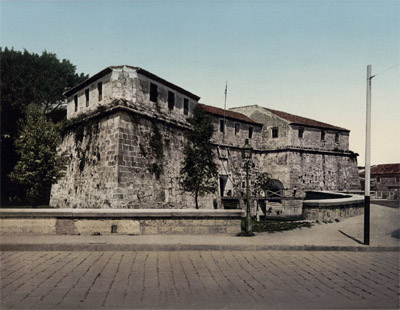 Our Castillo in a postcard published by the Detroit Photographic Company, helpfully dated circa 1897-1924. Our Castillo in a postcard published by the Detroit Photographic Company, helpfully dated circa 1897-1924. |
|
Despite all of these impressive forts having been arrayed to prevent just such a thing, a Dutch fleet made it into Havana's harbor in 1628, and plundered all of the Spanish ships therein. This was during the Eighty Years' War (1568-1648), which was essentially the Netherlands' effort to get Spain out of the Netherlands, so one might understand such behavior. The Dutch in this case made off with a truly tremendous amount of Spanish loot, a reported 11,509,524 guilders' worth, which was enough to fund their war effort against Spain for a few years.
The Castillo de la Real Fuerza's most distinctive feature, as far as Havanans are concerned, is its Watchtower, which was added to the Castillo's western bastion in 1634. This was probably made necessary by the growth of the city, which would have made it difficult for those in the fort to keep an eye on the mouth of the harbor. Atop this watchtower was placed a weathervane, sculpted as a woman, forever looking out to sea: La Giraldilla. This is thought to represent Isabel de Bobadilla (1505-1554), Cuba's first lady Governor, who spent years waiting for her husband, Hernando de Soto (1497-1542), to return from Florida. He never did (because he died there), and she magically morphed into a bronze wind statue.
|
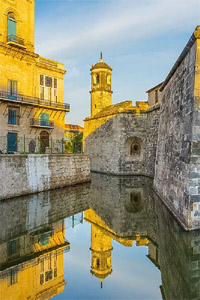
The Castillo's watchtower, added in 1634. |
 |
After the Dutch incursion of 1628, the enemies of Spain never managed to force their way into Havana Harbor again. The city was captured by the British during the Seven Years' War (1756-1763), but this was achieved by 4,000 British troops besieging Havana in the summer of 1762. The Treaty of Paris that ended the war saw Spain trading Florida for Cuba, which nestled gratefully back into the comforting Spanish bosom.
While the Castillo de la Real Fuerza is pretty impressive today, it was originally surrounded with what were probably equally impressive outerworks. A monument called El Templete, representing the first mass of San Cristobál de Habana which took place in 1519, was built just to our Castillo's southeast in 1828. El Templete was a jealous monument, which feared that the looming outerworks of the Castillo would overshadow the monument's majesty. This plus a desire for O'Reilly Street to extend to the water's edge prompted the authorities to do away with those pesky outerworks in 1851. Which is a shame from a starfortilogical point of view, but frankly we're fortunate to have as much of the Castillo left as we do!
|
|
|
Unfortunately for Spain's ambitions to retain her colonies in the Western Hemisphere, the United States at the end of the 19th century had more national pride and military capability, particularly of the naval variety, than it knew what to do with. The battleship USS Maine steamed into Havana Harbor in January of 1898, notionally to protect American interests during the ongoing War of Cuban Independence, but all it really accomplished was blowing up for unexplained reasons, taking with it 261 American seamen. Hooray, bellowed many Norteamericanos, we now have an excellent excuse to take Spain's colonies away!
|
And take them away the United States did. There are many lovely pictures of Havana's starforts with 45-star American flags flying over them in 1898 at the Library of Congress' website, but none of the Castillo de la Real Fuerza during that period. "What, that little thing next to El Templete? Why would we fly a flag over that?!"
Over the course of the 20th century, the Castillo de la Real Fuerza served as the headquarters of several different governmental organizations. For a time it housed Cuba's Museum of the Arts, until it was discovered that a 400-year-old starfort in an intensely humid climate was an absolutely terrible place to store valuable art, at least prior to the widespread use of air conditioning.
|
 |
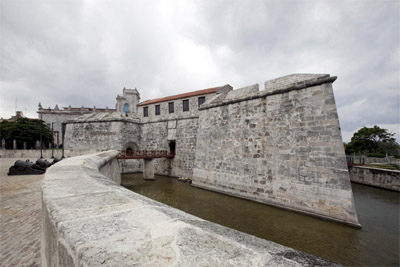 The Castillo de la Real Fuerza's eastern side in 2010. Thanks, LOC.gov! The Castillo de la Real Fuerza's eastern side in 2010. Thanks, LOC.gov! |
|
In 1990, the Castillo became the National Museum of Cuban Ceramics, which distinction it still holds today. Fortunately for those of a non-ceramic bent (such as myself), it also became the Cuban Maritime Museum in 2010. Today in addition to those two museums, there is reportedly a café somehow crammed in the tiny fort as well, and one can experience all of this historic goodness for a low, low entry fee.
A concluding mea culpa: In 2010, when Starforts.com was a budding enterprise, I created a page for the Castillo de la Real Fuerza, but being new at this and completely bereft of any sense whatsoever, I misidentified it as the Palacio de Segundo Cabo. Somehow this foolish mistake went unnoticed for 14 years, until a Spanish gentleman by the name of Miguel Vicente was kind enough to point out how wrong I was, which he had the grace to do without calling me an idiot, though I clearly am, or at the very least was in 2010. The Palacio de Segundo Cabo was essentially a post office, which I did find rather odd at the time, but not odd enough to take a second glance at the map. Thank you, Señor Vicente, for setting me straight. I promise to never make a mistake again.
|
|
|
|
|
|
 |




